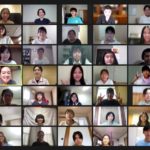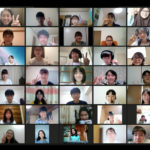[Report] The Hiroshima Junior International Forum (December 13)
The 5th Hiroshima Junior International Forum concluded on December 13, 2020 with the presentation of the “Hiroshima Declaration”, an action plan for furthering the cause of nuclear disarmament and peacebuilding.

The Hiroshima Junior International Forum goes online due to the COVID-19 pandemic
30 high school students from 14 countries took part in this year’s Hiroshima Junior International Forum. In a normal year, the participants gather in Hiroshima for four days which culminates with the announcement of a single declaration. However, due to the ongoing COVID-19 pandemic, the 2020 event took place online over three sessions spread over 3 weeks and each of five groups issued their own declaration.
Moving the process online presented a challenging environment, but did not dampen the enthusiasm of the participants. After taking part in a series of workshops in which they heard from hibakusha,an A-bomb survivor, and experts on nuclear disarmament and peacebuilding, the students turned their attention to discussing the challenges facing progress on these critical issues, to possible solutions and how they themselves can contribute. The results of these discussions were distilled into their Hiroshima Declarations.
The declarations covered four main areas:
・The abolition of nuclear weapons
・Peacebuilding
・The role of young people
・The role of Hiroshima
The abolition of nuclear weapons
A global environment characterised by mutual distrust and governance focused on self-interest is seen as the greatest obstacle to nations reducing their nuclear arsenals. Lack of awareness among the general populations of the world at large concerning issues related to nuclear weapons is also pointed to as hampering challenges to the status quo.
The
establishment of more international conferences and projects through
which greater mutual understanding and awareness of the particular
concerns and cultural considerations of different nations could be
fostered is proposed in several of the declarations. All groups
called for the introduction and development of educational programs
which deal with nuclear weapons, covering the history and motivations
behind their development, how they were tested, how they have
affected the world so far and the danger they present for the future.
Such education would lead to the consensus that nuclear weapons are a
danger to the world that needs to be eradicated, creating a
widespread negative bias against them; an essential first step on the
path to abolition. The widespread sharing of the testimony of
Hiroshima and Nagasaki’s hibakusha A-bomb survivors is also seen as
an important way to convey the level of threat that nuclear weapons
present to the world, to create a kind of “nuclear taboo” as one
group described it.
One group makes the point that lack of belief in whether the abolition of nuclear weapons is actually achievable and doubts about the strength of international organizations working for abolition are major obstacles to change. Participation in international campaigns such as the International Campaign to Abolish Nuclear Weapons (ICAN) and the ratification of international agreements such as the Treaty on the Prohibition of Nuclear Weapons (TPNW) and the Nuclear Non-Proliferation Treaty (NPT) is seen as a key step in shifting the consensus that nothing can be done. The participants take hope from the small nations that are taking a stand against nuclear weapons and see them as models to emulate to create “peer pressure” among nations to change the view that nuclear weapons are a necessary evil. Another group stressed that Japan should itself take up the position as the leader of the movement to rid nuclear weapons from the world by ratifying the TPNW and that the organization of mass petitions is one way to persuade the national government to do so.
Peacebuilding
Although the path to the abolition of nuclear weapons may still be a long one, it does, at least, have a clear objective. Issues surrounding peacebuilding are no less challenging and are open to a wide range of interpretations. In the sections of the Hiroshima declarations addressing peacebuilding, participants showed an appreciation of its complex nature based upon the lectures and discussions during the forum.
That the notion of “peace” has many and diverse meanings was accepted by all groups. Beyond the absence of actual armed conflict and violence, described as “negative peace”, all the groups acknowledged that concerted efforts must be made towards building “positive peace” and eliminating elements of structural or invisible violence, which are key barriers to peacebuilding.
The declarations recognized that resolving structural inequality in the areas of wealth, gender and education is at the very core of peacebuilding efforts and that greater equality in any one of these areas contributes to improvement in all three. One group pointed to development directed in accordance with the United Nations Sustainability Goals (SDGs) as a way of addressing wealth inequality.
The overall tone of the 2020 Hiroshima Declarations is overwhelmingly positive and they are full of youthful confidence that these aims are achievable. That, however, they represent a huge challenge to the world is fully appreciated. It is significant that one of the declarations clearly acknowledges that differences in opinions, ideals and ethics are inevitable and that the aim of peacebuilding is to create space and systems in which these differences are resolved based upon mutual understanding before they result in conflict. Forums such as this provide a real life opportunity to practice these skills, recognized in the general closing remarks and all the declarations stress the importance of organizing forums and events for people from all countries, cultures and beliefs to engage with each other and that our education systems prepare future generations for such interaction.
The role of younger generations
All the participants feel strongly that knowledge is very much the key to peace building and that while peace education should be a larger component of school curricula, in the meantime, they feel a responsibility to educate themselves on issues related to nuclear weapons and peacebuilding.
All groups mention the more effective use of social media to encourage interest in political issues among young people and spread awareness of how they can contribute to making a change in the world around them, whether by voting, petitioning or taking part in events, seminars and conferences to promote peace. While acknowledging that social media can be used as a propaganda tool that sows discord rather than promote peace, one of the declarations includes a proposal to reach out to the social media companies themselves to devise ways to increase engagement on peace related issues.
The Role of Hiroshima
That the opportunity to listen to A-bomb survivor testimonies deeply impressed the participants is evident in the fact that all the declarations included the wider sharing of these important stories as a key element in galvanizing abolition and peacebuilding efforts. They also called for continued and active preservation of A-bombed buildings such as the A-bomb Dome and the hifukusho (Hiroshima Army Clothing Depot) to stand as memorials to the bombing for decades to come.
The participants are clearly keen, ambitious and ready to take action. However, they also look to Hiroshima to take the lead as a center for peace, provide support and create some of the structures necessary for the implementation of pledges made in their declarations. Among these, as well more frequent forums such as the Hiroshima Junior international Forum, they call for Hiroshima to host more relaxed events at which people from around the world can come together and for the export of Hiroshima style peace education around the world. Most of all, they called for Hiroshima to leverage its unique position in the world, earned through great tragedy to act as a bridge between cities and around the world.
In conclusion
The participants in the 2020 HIroshima Junior International Forum see their declarations not only as the end of the forum, but as a starting point for future action. As they say in their collective closing remarks, “As global citizens and future young leaders of the world, we are here to make small changes for bigger changes towards a fully denuclearized, demilitarized, and peaceful world. Recognizing our power and responsibilities, we hereby strongly declare our determination.” We wish all the participants well and look forward to their future steps.

See Hiroshima Junior International Forum Declaration
Tags associated with this article







